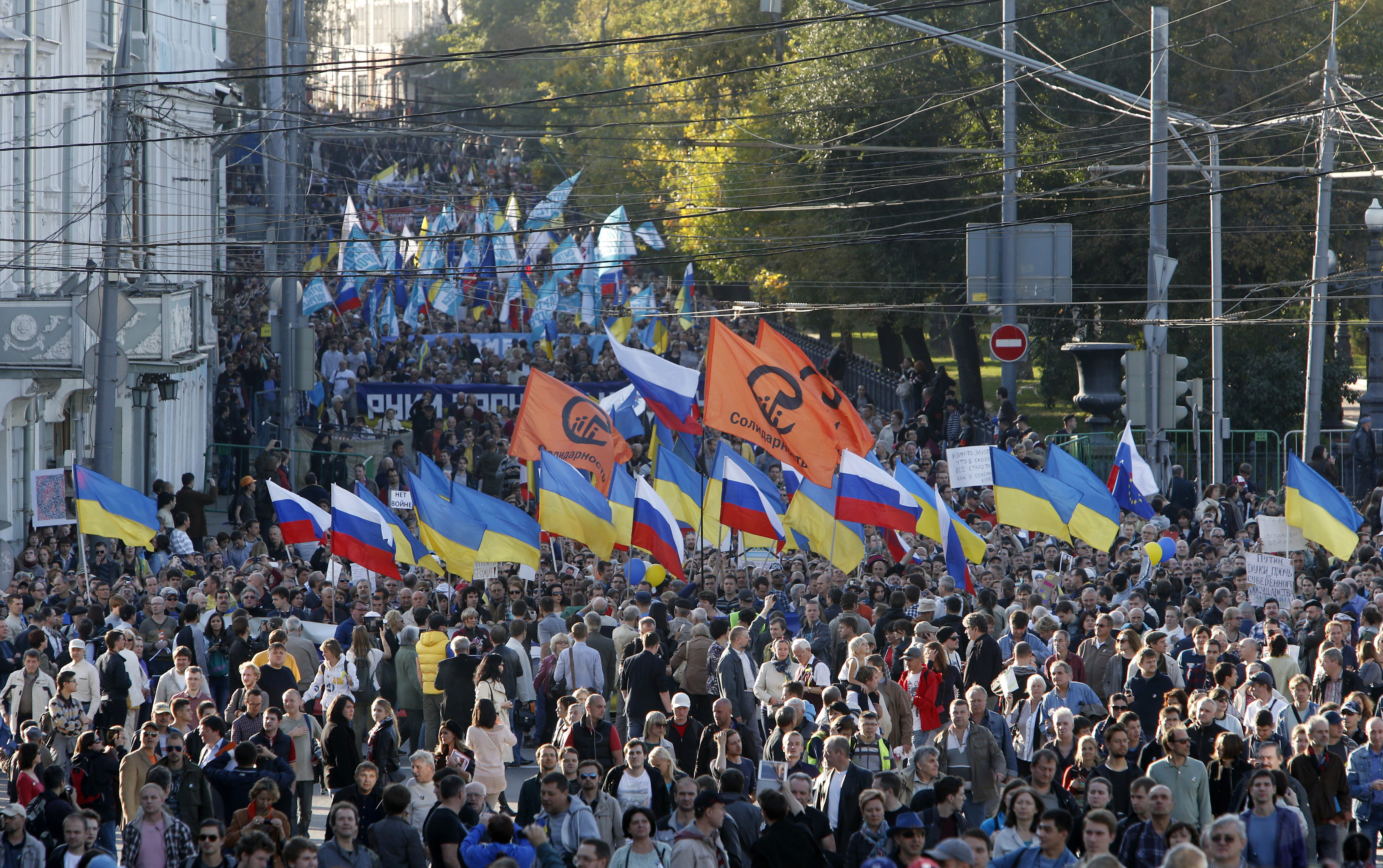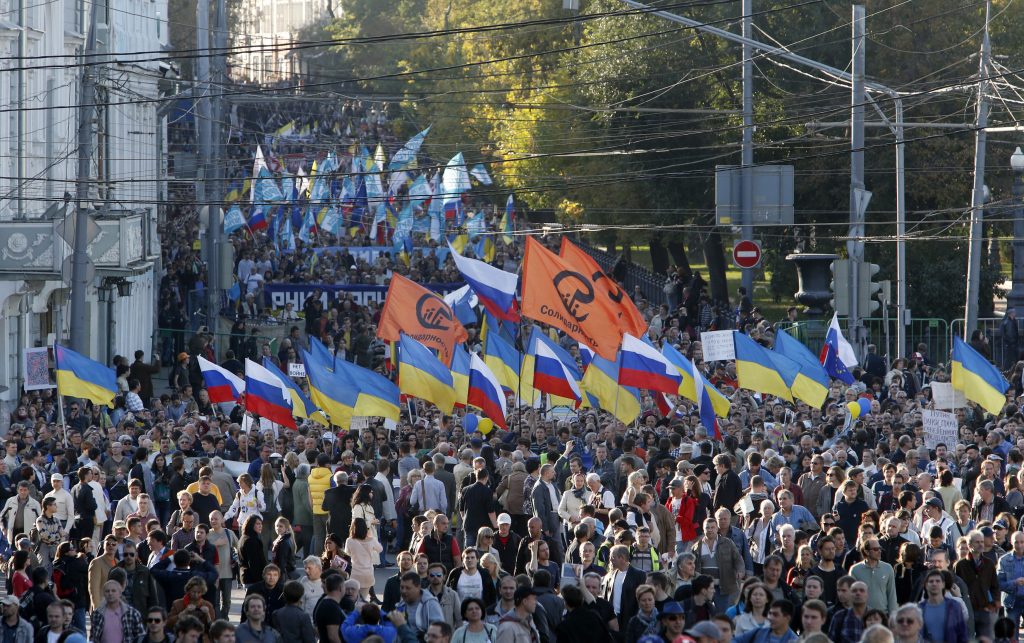
Like Poroshenko’s Reception in Congress, It’s a Morale Boost—But Ukraine Is Fighting on Its Own
Yesterday’s images from Moscow could hardly be more welcome for Ukrainians: thousands of Russians marching in their capital to condemn their government’s war against Ukraine. The protest was fueled partly by the spreading news in Russia that scores, perhaps hundreds, of Russian infantry, armored and artillery troops have been killed in Russia’s invasion of Ukraine, and secretively buried.
The Peace March drew about 26,000 people, the first major public protest against Russian President Vladimir Putin’s assault on Ukraine since an estimated 50,000 rallied March 15 to oppose his seizure of the Crimean Peninsula. It buttressed one of Putin’s most prominent opponents, the former oil billionaire Mikhail Khodorkovsky, as he declared his return to active political opposition. Khodorkovsky, living in Switzerland, spoke to three European newspapers, announcing the revival of his Open Russia foundation to support pro-democracy candidates against Putin in the 2016 parliamentary elections.
Like last week’s standing ovations in US Congress for Ukraine’s visiting president, Petro Poroshenko, yesterday’s images of Muscovites waving the Ukrainians’ blue and gold flag was a vibrantly emotional endorsement of their fight—but it may lack any immediate impact beyond a morale boost.
Khodorkovsky vs. Putin
Khodorkovsky, whom Putin freed last year from a decade in prison, captured the uncertainties of opposing an increasingly authoritarian leader who now dominates all of Russia’s political institutions, including the mass media and the Russian Orthodox Church. Khodorkovsky told the Spanish daily El Pais in an interview that “I’m pessimistic” about any early change in Russia’s government. Putin could remain in power “between two years, if he makes mistakes, and twenty years,” Khodorkovsky said.
Poroshenko’s visit to Washington raised Ukrainians’ hopes that they might persuade Congress to provide US weapons for their defense, after the Obama administration has declined to do so. But that is no sure thing, and as the Atlantic Council’s Eurasia Center director, John Herbst, noted last week, it is unlikely to happen in any case until the end of the year. Amid a cease-fire that has been shaky and violent from its start seventeen days ago, Ukraine must face Russia and its army alone.
“It’s not possible to win … purely by military means,” Poroshenko told Ukrainian journalists yesterday. “The more Ukrainian army battalions or brigades are brought up, the more troops there are from the Russian Federation,” he said. Poroshenko said that as much as 60 to 65 percent of Ukraine’s heavy military equipment has been destroyed in the fighting so far.
While Putin retains public approval ratings above 80 percent, according to opinion polls by the Moscow-based Levada Center, the Ukraine war is ultimately corrosive of his support. About 56 percent of Russians surveyed by Levada during August 22-25 believed the Kremlin’s assertion that it has not sent forces into Ukraine, while 32 percent said their government has intervened. If Russians understand that their government is indeed fighting Ukraine directly, they are nearly evenly split on whether to support that policy, Levada says.
Russia’s Cover-Up: Troops Killed in Ukraine
That split in opinion makes it significant that the news of Russian soldiers’ deaths is spreading, despite government denials, the silence of the state-dominated news media, and attacks by thugs against journalists who try to visit the cemeteries or interview the relatives of the men killed. The increasing documentation of Russia’s semi-covert invasion, and accounts of those who have been killed, has included these developments:
- One of the organizers of yesterday’s Peace March, political and environmental activist Yelena Vasilyeva, said that, increasingly, “the general mass of the people understands what actually is happening in Russia and Ukraine.”
- Vasilyeva helps to run a Facebook group called Gruz 200 (“Cargo 200”), a reference to the Russian military code for a shipment home of soldiers’ bodies. The group lists 20,000 members—including Russians, Ukrainians and others—who are following the fate of the Russian troops who are unaccounted for. “Refrigerator trucks drive from Ukraine to Russia, carrying the bodies of the dead,” the group says on its page. “But Russia’s mass media prefer to keep silent about those who are dying on Ukrainian soil. This group has been established to establish a record of those killed.”
- On September 21, the New York Times reported on the deaths of dozens, some say hundreds, of Russian soldiers killed in Russia’s invasion, such as Russian tank crewman Sgt. Vladislav Barakov.
- On September 18, the BBC reported on the death of Konstantin Kuzmin, from a Russian village 40 miles outside the southern city of Astrakhan. As the BBC crew returned from interviewing Kuzmin’s sister in their Kuzmin’s village, they were first stopped by police, then later attacked by a group of unknown thugs. While they were subsequently treated at a local hospital and engaged with police, their car was broken into and their computers and other equipment had their data erased.
- On September 17, the Russian regional weekly newspaper Pskovskaya Guberniya reported that secretive burials are continuing of soldiers killed in connection with the combat role in Ukraine of the Pskov-based 76th Airborne Division. Reporter Alexei Semyonov cites 38 names of troops confirmed dead, and says scores of others from the Pskov area are reported missing in lists circulated among area residents.
- On August 29, a Pskov province legislator and Pskovskaya Guberniya publisher, Lev Shlosberg, was attacked by thugs August 29 as he left his office, after he had reported on the secret burials around the Pskov region.
- On August 29, Russia’s Justice Ministry declared the Soldiers’ Mothers Committee of St. Petersburg, one of Russia’s most prominent soldiers’-rights advocacy groups, a “foreign agent” after the committee requested a meeting with government officials seeking information about soldiers wounded or killed in Ukraine.
- On August 26, thugs attacked a carload of journalists from Dozhd (“Rain”) TV, one of Russia’s few remaining independent news media, as they visited a cemetery where soldiers killed in the war had been buried.
- On June 2, Russian journalist Maria Turchenkova published an eyewitness account of Russian army veterans killed in the Ukraine war, and the odyssey of their bodies’ return in a refrigerated truck to Russia.
- Throughout the summer, Russian soldiers’ posts on the Russian version of Facebook, called VKontakte, and selfies posted to Instagram, plus videos of Russian attacks across the border posted on the Internet by Russian residents of the border zone, have documented Russia’s war on Ukraine.
James Rupert is an editor at the Atlantic Council.
Image: A crowd estimated at 26,000 people marches through Moscow September 21 in a a protest against Russia’s war on Ukraine. Many marchers carried the blue and yellow Ukrainian flag or the white, blue, and red Russian tricolor. (REUTERS/Sergei Karpukhin)
